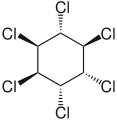


Figure: Molecular structure of Lindane (γ-HCH), α-HCH and β-HCH
ALS offering for Lindane testing
|
Matrix |
LOQ |
Sample volume |
|
Soil |
0.001 mg/kg DW |
10 g |
|
Sediment |
0.001 mg/kg DW |
10 g |
|
Water |
0.01 µg/L |
0.5 L |
ALS OFFERING FOR ALPHA- AND BETA HCH TESTING
|
Matrix |
LOQ |
Sample volume |
|
Soil |
0.01 mg/kg DW |
10 g |
|
Sediment |
0.01 mg/kg DW |
10 g |
|
Water |
0.01 µg/L |
0.5 L |
Overview
Lindane
Lindane was first synthesised as far back as 1825 but it was not until the early 1900 that Tenius van der Linden described the compound properly. The compound also takes it’s name from van der Linden.
Lindane or γ-HCH is the only of the isomers with insecticidal properties and has been used extensively as a seed and soil treatment and to treat food crops, livestock and pets. In addition to the use as an insecticide, Lindane has also been applied to shampoos and lotion’s to treat lice and scabies.
Lindane was included as a POP under the Stockholm convention in 2009.
Toxicity
Lindane is classed as extremely hazardous and moderately acutely toxic and also as a known human carcinogen by the IARC
Overview
α-HCH and β-HCH
Neither α-HCH nor β-HCH has ever been commercially produced but is a by-product in technical grade Lindane.
α-HCH and β-HCH was both included as POP’s under the Stockholm convention in 2009.
Toxicity
Both α-HCH and β-HCH is classed as a possible human carcinogen. α-HCH is slightly toxic to humnas and highly toxic to fish and insects while the beta version of HCH is classed as moderately toxic to fish and has not be classed for human toxicity.
Table: International threshold values for Lindane
|
Country |
Matrix |
Limit |
|
The Netherlands |
Soil |
0.0005 mg/kg DW1 |
|
The Netherlands |
Sediment |
0.23 mg/kg2 |
|
Sweden |
Sediment |
0-1.3 µg/kg3 |
|
The Netherlands |
Water |
0.91 µg/l2 |
|
The Netherlands |
Water |
9 ng/l1 |
|
Norway |
Water |
0.02-0.2 µg/l4 |
- VROM (2000) Streefwaarden en interventiewaarden bodemsanering. Staatscourant 24 february 2000/39.
- Crommentuijn et al., Journal of Environmental Management 58 (2000): 297
- Swedish EPA report 4914. Limit depending on classification
- 2229/2007, Norwegian Pollution Control Authority. Limit depending on classification


